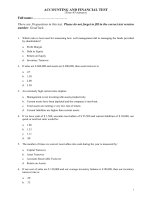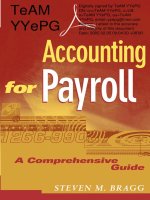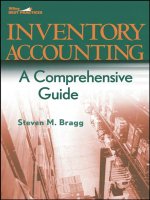lecture1 accounting
Bạn đang xem bản rút gọn của tài liệu. Xem và tải ngay bản đầy đủ của tài liệu tại đây (1.51 MB, 32 trang )
Lecture 1
Introduction to Banking
Systems
1-1
OUTLINE
Financial Institutions
The Structure of the Financial Industry
Bank, Bank Operation, Types of Bank and
Types of Bank Account
Bank Services
What is Money, The History of Money
Interest Rate and How Calculate Interest
Rate
1-2
Simple present Value
Financial Institutions
A
financial
institution
(FI)
is
a
company engaged in the business of
dealing with financial and monetary
transactions
such
as
deposits,
loans, investments,
and
currency
exchange.
Financial
institutions
encompass a broad range of business
operations within the financial services
sector including banks, trust companies,
insurance companies, brokerage firms,
and investment dealers.
3-3
The Structure of the Financial
Industry
We
can divide intermediaries into two
broad categories:
◦ Depository institutions,
Take deposits and make loans
What most people think of as banks
◦ Non-depository institutions.
Include insurance companies, securities
firms, mutual fund companies, etc.
3-4
Bank
A
bank is a commercial or financial
institution
that
provides
financial
services, including issuing money in
various forms, receiving deposits of
money, lending money and processing
transactions and creating credit.
There are various types of banks. The
necessity for the variety among these
banks is because each bank is
specialized in their own field. Each
bank has its own principles and
policies. Different rates of interests
are also noted among these banks.
Bank Operation
Deposit
Deposito
rs
Loans and Credits
Banks
Withdrawal of
deposit along
with interest
Repayment of
loans and credits
along with
interest
History of Banking
Joint stock
commercial
banking
Bank of
England
1716
Bank of
Amsterdam
1690
1694
1833
General
private
bank
(France)
1401
&1407
160
9
Bank of
Hamburg
Bank of
Venice
1157
Bank of
Barcelona
and the
bank of
Genoa
Types of Banks
Commercial banks
Community banks
Community development
banks
Land development banks
Credit unions or Co-operative
Banks
Postal savings banks
Private banks
Offshore banks
Building societies and
Landbanks
Spare Bank
Exchange Banks
Consumer’s Bank
Ethical banks
Direct or Internet-Only bank
Investment banks
"underwrite“
Merchant banks
Universal banks
Central banks
Islamic banks
Savings Banks
Indigenous Banks
Mortgage Banks
Internet Bank
Types of Banks
Savings
Banks – these banks are suited
for employees with a monthly salary. Low
waged people may open an account in the
savings
bank.
Commercial
Banks – These bank collects
money from people in various sectors and
gives the same as a loan to business men
and make profits in interests these
business men pay. Since the loan is large
the
interest
rates
are
also
high.
Types of Banks
Internet Bank – provides banking facilities
only via internet. There will be no
physical contact with the bank. All
transactions are permitted only through
online.
Islamic banking refers to a system of
banking or banking activity that is
consistent with Islamic law (Sharia)
principles
and
guided
by
Islamic
economics. In particular, Islamic law
prohibits
usury,
the
collection
and
payment of interest, also commonly
called riba in Islamic discourse.
Central Bank
A central bank is a financial
institution given privileged control
over the production and distribution
of money and credit for a nation or a
group
of
nations.
In
modern
economies, the central bank is
usually
responsible
for
the
formulation of monetary policy and
the regulation of member banks.
Bank sector in Kurdistan region?
Challenges
How can we develop this sector?
….
GROUP DISCUSSING
The functions of the Central
Banks
Cashes
checks for banks
Makes loans to banks
Collect checks for banks
Supervise all national banks
Issuing money
Raises and lowers interest rates
Attempts to control inflation
Teamwork activity
Each
Group have to prepare a seminar
about Central bank of a country.
Deposit Facilities and Banking
Services
• A deposit is the act of placing cash (or
cash equivalents) with some entity,
most commonly with a financial
institution such as a bank.
• A person who is making a deposit
with the bank is known as a
depositor. The depositor is the lender
of the money which will be returned to
him/her at the end of the deposit
period.
Various Accounts and Deposit
Facilities for Depositors
1. Savings account
2. Current account
3. Fixed account
Saving Deposit
Account
As the name suggests this type of account is
suitable for the people who have a definite
income and are looking to save money. This
type of account can be opened with a
minimum initial deposit.
Money can be deposited at anytime in this
account. Withdrawals can be made either by
signing a withdrawal form or by issuing a
cheque or by using ATM card. Interest is
Current Deposit account
Big
businessmen,
companies
and
institutions such as schools, colleges, and
hospitals have to make payment through their
bank accounts. Since there are restrictions on the
number of withdrawals from savings bank
account, that type is not suitable. Banks open a
current account for them. Like savings, this also
requires minimum initial deposit. Here, bank
does not pay any interest. Rather the account
holder pays a certain amount each year as an
operational charge.
Fixed (Time or Term)Deposit
Account
Some bank customers may like to put away
money for a longer time. Such deposits offer a
higher interest rate. If money is deposited in
savings bank account, banks allow a lower rate of
interest. Therefore, money is deposited in a fixed
deposit account to earn an interest at a higher
rate.
Various Banking Services
• Advancing of Loans.
• Overdraft.
• Discounting of Bills of
Exchange.
• Check/Cheque Payment
• Collection and Payment Of
Credit Instruments
• Foreign
Currency
Exchange.
• Bank Guarantee.
• Credit cards.
•
•
•
•
•
ATMs Services.
Debit cards.
Home banking.
Online banking.
Mobile Banking.
What is money?
Money is anything that
serves
as
a
commonly
accepted
medium
of
exchange.
1-23
The Evolution of Money
1-24
Barter : which consists of the exchange of goods
for other goods.
Commodity Money : cattle, olive oil, beer or wine,
iron, and cigarettes.
Metallic Money : With progress of human
civilization,
commodity
money
changed
into
metallic money. Metals like gold, silver, copper, etc.
Paper Money : Paper money is a country's official,
paper currency
that
is
circulated
for the
transactions involved in acquiring goods and
services.
Credit Money : Credit money is monetary value
created as the result of some future obligation or
claim. Like bonds and money markets.
Digital Money: or digital currency, refers to any
means of payment that exists purely in electronic
form. Like Bitcoin.
INTEREST RATES
The interest rate is the price paid for
borrowing
money
and
deposit.
we
usually calculate interest as percent per
year on the amount of borrowed funds
and deposits. there are many interest
rates,
depending
upon
the
maturity,
risk, tax status, and other attributes of
the loan.
1-25









